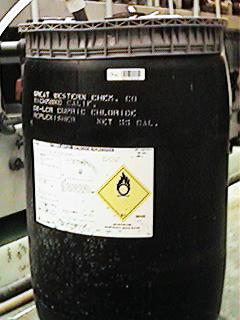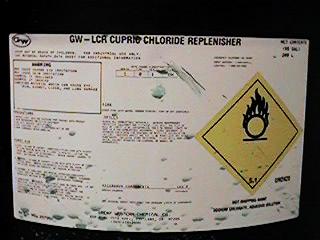Vis-U-Etch Cupric Chloride Etcher Controller
Oxford V.U.E., Inc.
11711 Clark St., Ste 108
Arcadia, CA 91006
USA
ph.(626) 256-6557
fax(626) 256-6567
www.oxfordvue.com
|
|
|||||||||||||||||
|
Machine Meets Chemical By David Pickering In previous issues you have learned about our revolutionary glass light cell that affords precision dispensing of chemistry and long term oxidizer resiliants. Today, Oxford V.U.E., Inc. is proud to announce the formulation of chemistry that enhances the benefits of the new light cell technology. This new chemistry was formulated in cooperation with Great Western Chemical Company. The product is named, "GW LCR-Liquid Chlorate Replenisher". This chemistry is based on sodium chlorate but includes buffering agents that help to enhance the performance and reliability of the Vis-U-Etchtm 5system. This new system combines high-speed etching with quality results while improving safety and environmental compliance. Speed: GW LCR is formulated to maintain copper concentrations of 32 ounces per gallon in the working solution. Due to this high copper concentration, Great Western's LCR is capable of etch speeds almost twice that of traditional cupric chloride systems. This coupled with the fact that the equipment and chemistry require no excess acid to compensate for etch rate, produces a copper trace far superior to those systems controlled by ORP and normality. Quality: Because pure cupric chloride is maintained by this system, an etch factor of 6.7:1 is achieved, whereas, with high acid normality based systems, that must sacrifice etch factor for speed, produce mixed results (Hydrochloric acid etch factor 1.3:1 coupled with pure cupric chloride of 6.7:1 leaving an unpredictable, ragged trace). With the Vis-U-Etchtm 5/ Great Western system, two mil lines and spaces are already being achieved in production lines with an unparalleled consistency. Safety: Historically chlorine "gas-outs" in light cell controlled systems have been contributed to two factors: An acrylic light cell that degraded over time causing over adds of oxidizer and a customer driven problem of inaccurately mixed oxidizer solutions. With the introduction of the glass light cell, equipment failure is eliminated and with GW LCR, a consistently reliable oxidizer content is maintained making "gas-outs" a thing of the past. Although free chlorine is an ever-present phenomenon in every cupric chloride regeneration system, GW LCR limits this occurrence by the addition of buffering agents that actually tie-up any excess chlorine produced during the regeneration process. This buffering action coupled with a Vis-U-Etchtm 5controller that responds reactively adding only enough to maintain a "zero balance", rather than proactively, like ORP / normality type systems, creates a safe working environment for both equipment and employee. Environmental issues: As previously mentioned, the "GW LCR" system runs at a copper concentration of 32+ ounces per gallon. This copper concentration compared to the copper content of traditional systems (17 - 25 ounces per gallon) reduces customer disposal volumes by as much as half. GW LCR is available in drum totes and bulk; therefore allowing far less handling of hazardous materials. GW LCR does not require the expensive handling and storage equipment required by hydrogen peroxide or chlorine gas, and, GW LCR does not carry the high fire risk found with storage and handling of dry sodium chlorate. Additional productivity benefits:
To learn more about "GW LCR-Liquid Chlorate Replenisher" contact Phil at Oxford V.U.E., Inc. by calling, 626-256-6557 or Great Western Chemical Company by calling 562-463-1477 The Baume Inspection Tube We all know that the Vis-U-Etchtm process does not use baumé (specific gravity), acid normality or ORP to determine what is needed for regeneration. Anyone who has ever used a different controller and chemistry for cupric etchant realizes that the baumé has a tendency to fluctuate within a certain range. This is due to the fact that the chemistry is constantly changing and is never really balanced properly. Further proof comes from watching the fluctuations in acid normality and ORP. For Vis-U-Etchtm users, the etchant is the most stable due to the fact that no chemicals are added until actually needed and held as close to that point as possible. This is the reason for acid normality at or near 0N. If the competing chemistry is so balanced, why do you have to waste all that free acid? If you want to see how much is wasted, determine the normality in your spent tank before you send it away. Anyway, back to baumé. We recommend keeping a baumé hydrometer in the inspection tube for a couple of reasons. The first is the baumé reading at operating temperature will pick a point and stay there, unlike ORP / normality systems that fluctuate and keep diluting the etchant with water. The baumé reading is determined by oxidizer concentration, calibration setting, altitude of your location, humidity and so on. This is important in helping you to determine if anything has changed in the condition of your etchant. If that happens, you can anticipate problems and their cures rather than react to them later. The second reason is that with a baumé hydrometer floating in the tube you can easily pull it out and inspect the last drip on the bottom for clarity of the etchant. This aids in verifying the calibration of the Vis-U-Etchtm. For example, if the etchant is not clear green, regeneration should be taking place. If the etchant is clear green and regeneration is taking place accompanied by a chlorine smell, the calibration is set too low. Adjust both meters slightly higher (one light bar on each) and then check again after etching about 10-15 minutes. This gives enough time for the etchant to adapt to the new setting. For complete calibration instructions, read the owner's manual. If you have misplaced your owner's manual and need a replacement, give us a call. ORP Probes A clean and properly calibrated ORP probe can also be helpful in calibration. The Vis-U-Etchtm typically regenerates with oxidizer when the ORP drops to approximately 560-580mv. Regeneration stops at about 610mv. The safe operating range of ORP is 520mv-680mv. Below 520mv, the ORP is too low causing regeneration and etch rate problems. Above 680mv, chlorine gas is produced which cannot be absorbed back into the etchant and is released into the atmosphere. Operating within the safe range yields very consistent etch rates and no problems. The main reason that high normality acid systems have problems with ORP is that they have so much wasted free acid in the etchant for the oxidizer to react with. As a result, ORP must be kept as close to 520mv as possible. Any higher and chlorine gas is released which is a very common problem with those systems. Chemically Speaking... With a Vis-U-Etchtm system, there is no free acid. That enables the wider ORP range. Another contributing factor to this wider range is the salt in the oxidizer. Salt provides a very safe and stable storage of chlorine without any negative effects when kept at a minimum level, well below saturation. With salt (NaCl) in the etchant, the salt breaks down when needed to release chlorine for reforming cupric chloride (CuCl2) from cuprous chloride (CuCl) which keeps the etchant and etch rate stable. This leaves free sodium (Na) in the solution, which has no affect on the etching process. When the acid level starts to drop below 0N, cupric hydroxide (CuOH) is formed. This is corrected by the addition of acid (HCl). In the presence of oxidizer, the hydrogen (H) is split from the chlorine (Cl). The hydrogen (H) then combines with the hydroxide (OH) part of cupric hydroxide to reform water (H2O). The chlorine (Cl) is left to reform cupric chloride (CuCl2). The safety factor is in the left over sodium (Na). While chlorine likes the cuprous chloride better, once cupric chloride is reformed, the remaining chlorine (Cl) will now be happy to rejoin with sodium (Na). Salt (NaCl) is reformed. This explains the catalyst and buffer effect of salt in the etchant. As a final step, the GW LCR mentioned in the previous article fully optimizes this effect with a proprietary mixture of buffering agents. Because of this chemistry and the ability of the Vis-U-Etchtm to add replenishment only when needed, you end up with the most stable and cost effective cupric chloride etchant. This also proves why a reaction based system like the Vis-U-Etchtm is superior to a pro-active system like others use. With Vis-U-Etchtm, replenishment is added only when needed and only in the amount needed to maintain a perfectly balanced etchant. With pro-active systems, it's virtually impossible to predict how much copper will be added at all times. This explains why they frequently have problems with over-added chemistry and chlorine gas, not to mention the colossal waste. No Salt In The Etcher? We have gone to great lengths to balance the chemistry for the Vis-U-Etchtm 5system. Using the old recipe for oxidizer, an excessive amount of salt build up in the bottom of the etcher occurred creating clogging problems and excessive wear on the etcher components. With Great Western's new LCR, this problem is eliminated. Although there is still salt in the etchant, it is kept to a minimum, well below saturation. This preserves the buffer and catalyst effect without causing additional problems. It is now normal not to have salt on the bottom of the etcher. Mechanical Meters It has been brought to our attention that the mechanical meters used in the older VUE 3's and VUE 4's will no longer be available to us on an "off the shelf" basis. Due to declining demand these will be available only on a special order basis and at a substantially increased cost. We still have a few new meters left in stock and no rebuilt meters. If you would like to order a spare, we have the remaining stock available on a first come, first served basis at the old price but will not reorder any new ones unless we receive a prepaid purchase order. Thanks for your understanding. DON'T FORGET TO VISIT US IN BOOTH 1964 ACROSS FROM EXCELLON AUTOMATION AT IPC '98 IN LONG BEACH, CALIFORNIA. SEE YOU THERE!
|

